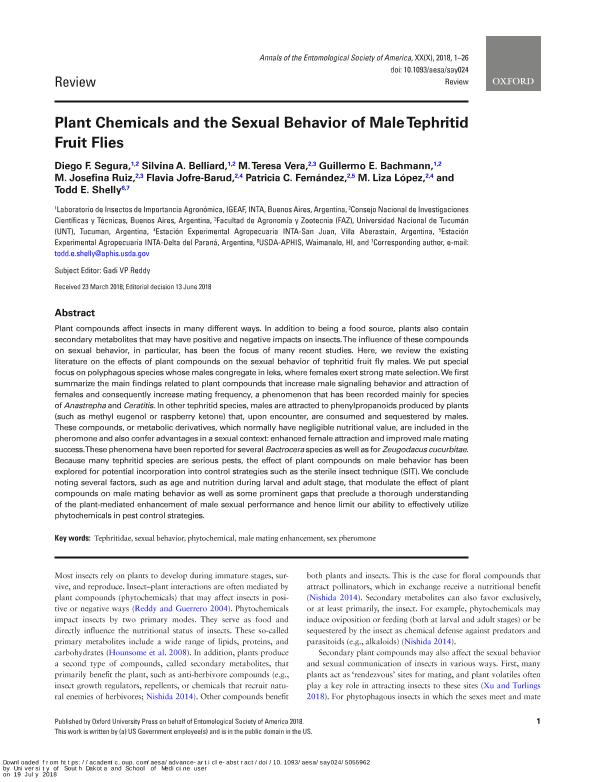Mostrar el registro sencillo del ítem
dc.contributor.author
Segura, Diego Fernando

dc.contributor.author
Belliard, Silvina Anahí

dc.contributor.author
Vera, María Teresa

dc.contributor.author
Bachmann, Guillermo Enrique

dc.contributor.author
Ruiz, María Josefina

dc.contributor.author
Jofré Barud, Flavia Beatriz

dc.contributor.author
Fernandez, Patricia Carina

dc.contributor.author
López, María Liza

dc.contributor.author
Shelly, Todd E.
dc.date.available
2019-09-05T20:37:11Z
dc.date.issued
2018-09
dc.identifier.citation
Segura, Diego Fernando; Belliard, Silvina Anahí; Vera, María Teresa; Bachmann, Guillermo Enrique; Ruiz, María Josefina; et al.; Plant Chemicals and the Sexual Behavior of Male Tephritid Fruit Flies; Entomological Society of America; Annals of the Entomologycal Society of America; 111; 5; 9-2018; 239-264
dc.identifier.issn
0013-8746
dc.identifier.uri
http://hdl.handle.net/11336/83009
dc.description.abstract
Plant compounds affect insects in many different ways. In addition to being a food source, plants also contain secondary metabolites that may have positive and negative impacts on insects. The influence of these compounds on sexual behavior, in particular, has been the focus of many recent studies. Here, we review the existing literature on the effects of plant compounds on the sexual behavior of tephritid fruit fly males. We put special focus on polyphagous species whose males congregate in leks, where females exert strong mate selection. We first summarize the main findings related to plant compounds that increase male signaling behavior and attraction of females and consequently increase mating frequency, a phenomenon that has been recorded mainly for species of Anastrepha and Ceratitis. In other tephritid species, males are attracted to phenylpropanoids produced by plants (such as methyl eugenol or raspberry ketone) that, upon encounter, are consumed and sequestered by males. These compounds, or metabolic derivatives, which normally have negligible nutritional value, are included in the pheromone and also confer advantages in a sexual context: enhanced female attraction and improved male mating success. These phenomena have been reported for several Bactrocera species as well as for Zeugodacus cucurbitae. Because many tephritid species are serious pests, the effect of plant compounds on male behavior has been explored for potential incorporation into control strategies such as the sterile insect technique (SIT). We conclude noting several factors, such as age and nutrition during larval and adult stage, that modulate the effect of plant compounds on male mating behavior as well as some prominent gaps that preclude a thorough understanding of the plant-mediated enhancement of male sexual performance and hence limit our ability to effectively utilize phytochemicals in pest control strategies.
dc.format
application/pdf
dc.language.iso
eng
dc.publisher
Entomological Society of America

dc.rights
info:eu-repo/semantics/openAccess
dc.rights.uri
https://creativecommons.org/licenses/by-nc-sa/2.5/ar/
dc.subject
Male Mating Enhancement
dc.subject
Phytochemical
dc.subject
Sex Pheromone
dc.subject
Sexual Behavior
dc.subject
Tephritidae
dc.subject.classification
Ecología

dc.subject.classification
Ciencias Biológicas

dc.subject.classification
CIENCIAS NATURALES Y EXACTAS

dc.title
Plant Chemicals and the Sexual Behavior of Male Tephritid Fruit Flies
dc.type
info:eu-repo/semantics/article
dc.type
info:ar-repo/semantics/artículo
dc.type
info:eu-repo/semantics/publishedVersion
dc.date.updated
2019-08-30T14:28:32Z
dc.journal.volume
111
dc.journal.number
5
dc.journal.pagination
239-264
dc.journal.pais
Estados Unidos

dc.journal.ciudad
Lanham
dc.description.fil
Fil: Segura, Diego Fernando. Consejo Nacional de Investigaciones Científicas y Técnicas; Argentina. Instituto Nacional de Tecnología Agropecuaria; Argentina
dc.description.fil
Fil: Belliard, Silvina Anahí. Consejo Nacional de Investigaciones Científicas y Técnicas; Argentina. Instituto Nacional de Tecnología Agropecuaria; Argentina
dc.description.fil
Fil: Vera, María Teresa. Consejo Nacional de Investigaciones Científicas y Técnicas; Argentina. Universidad Nacional de Tucumán. Facultad de Agronomía y Zootecnia; Argentina
dc.description.fil
Fil: Bachmann, Guillermo Enrique. Consejo Nacional de Investigaciones Científicas y Técnicas; Argentina. Instituto Nacional de Tecnología Agropecuaria; Argentina
dc.description.fil
Fil: Ruiz, María Josefina. Consejo Nacional de Investigaciones Científicas y Técnicas; Argentina. Universidad Nacional de Tucumán. Facultad de Agronomía y Zootecnia; Argentina
dc.description.fil
Fil: Jofré Barud, Flavia Beatriz. Consejo Nacional de Investigaciones Científicas y Técnicas; Argentina. Instituto Nacional de Tecnología Agropecuaria. Centro Regional Mendoza - San Juan. Estación Experimental Agropecuaria San Juan; Argentina
dc.description.fil
Fil: Fernandez, Patricia Carina. Consejo Nacional de Investigaciones Científicas y Técnicas; Argentina. Instituto Nacional de Tecnología Agropecuaria. Centro Regional Buenos Aires Norte. Estación Experimental Agropecuaria Delta del Paraná; Argentina
dc.description.fil
Fil: López, María Liza. Consejo Nacional de Investigaciones Científicas y Técnicas; Argentina. Instituto Nacional de Tecnología Agropecuaria. Centro Regional Mendoza - San Juan. Estación Experimental Agropecuaria San Juan; Argentina
dc.description.fil
Fil: Shelly, Todd E.. United States Department of Agriculture; Estados Unidos
dc.journal.title
Annals of the Entomologycal Society of America

dc.relation.alternativeid
info:eu-repo/semantics/altIdentifier/url/https://academic.oup.com/aesa/article/111/5/239/5055962
dc.relation.alternativeid
info:eu-repo/semantics/altIdentifier/doi/https://doi.org/10.1093/aesa/say024
Archivos asociados
